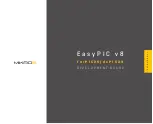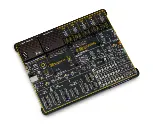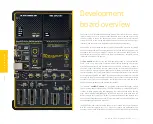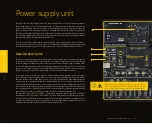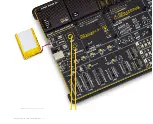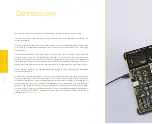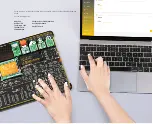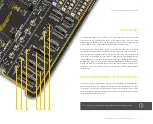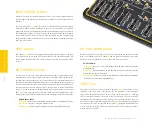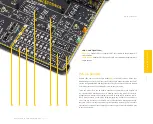
P A G E 6
E a s y P I C v 8 f o r P I C 2 4 / d s P I C 3 3
M a n u a l
O V E R V I E W
Development
board overview
The EasyPIC v8 for PIC24/dsPIC33 development board features a clean and intuitive
layout, allowing the user to instantly understand how to set it up and how to easily
tune it according to needs. The development board is divided into several sections,
arranged so that all the related interactive components such as switches, buttons,
indicators, and connectors, are logically positioned and grouped together.
Each section of the development board contains components important for reliable
operation of the board itself. The Power Supply Unit (PSU), the CODEGRIP programmer/
debugger module, and five mikroBUS™ sockets are located at the upper section of
the development board. This is where the MCU is powered from, programmed, and
interfaced with various Click boards
™
.
The
PSU module
provides a clean and well-regulated voltage for the development
board. It can use a wide range of external power sources, including a battery, an
external 12V power supply, and a power source over the USB-C connector. It supports
the power supply redundancy function (power ORing) for uninterrupted operation.
The onboard PSU module regulates, filters, and distributes the power across all the
connected peripherals. The development board is equipped with two touch-sensitive
buttons labeled as POWER and RESET. These buttons are used to power up the board
and reset the MCU. Their sleek design and flawless responsiveness add up to the whole
experience. These touch-sensitive buttons are resistant to wear over time and do not
exhibit any bouncing effect, unlike mechanical switches.
The powerful
CODEGRIP module
, an integrated programmer/debugger module
supports a wide range of different 16-bit PIC24/dsPIC33 MCUs, produced by Microchip.
It allows in-place programming and debugging of all the supported MCUs, offering
many useful programming/debugging options and seamless integration with the
Mikroe software environment. It also offers some powerful and unique features such
as the programming/debugging over WiFi; a feature that will revolutionize the way that
the embedded applications are developed.
The CODEGRIP module uses the USB-C connector for a reliable and secure connection
with the personal computer (host PC). It does not require any additional drivers
because it utilizes a HID driver model, natively supported by the computer's operating

